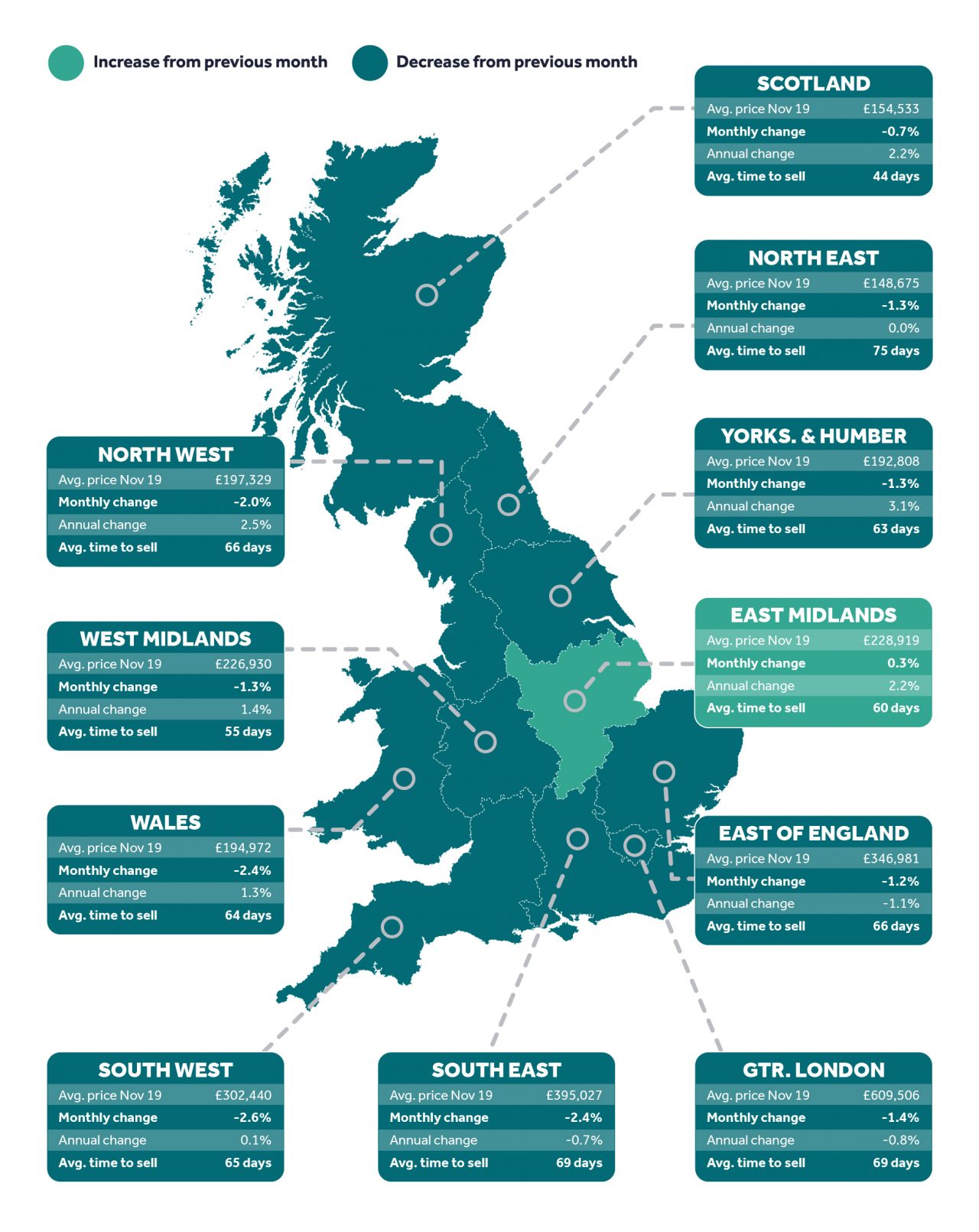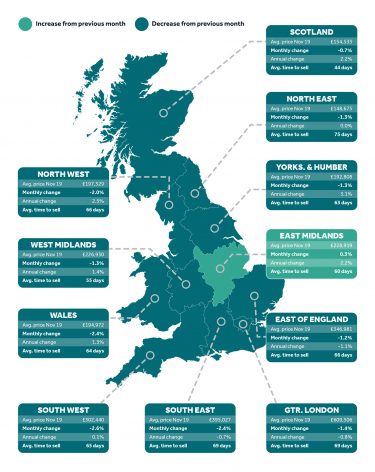House Price Index
Looming election deters sellers but cheaper prices tempt buyers
- The price of property coming to market falls by 1.3% (-£3,904) this month, and while drops are usual at this time of year it suggests opportunities for buyers to find a winter bargain
- 14.9% fewer new sellers than in the same period a year ago, deterred by lacklustre price growth and political uncertainty, the largest year-on-year slump in any month since August 2009
- In contrast, the number of sales agreed falls by just 2.9% compared to this time last year:
- Larger properties (four bedrooms or more) are the most active sector, with just 1.4% fewer sales agreed compared to 2018, as buyers benefit from prices 1.2% cheaper than last year
Overview
The price of property coming to market falls by 1.3% (-£3,904) this month, while the number of new sellers drops by nearly 15%. Would-be sellers are not only faced with the usual lower asking prices in the run-up to Christmas, but also a unique autumn combination of a Brexit deadline followed by a looming general election. These circumstances have proved to be a negative factor for thousands of prospective sellers, who have postponed their marketing plans. In contrast, there is positive news for buyers with new seller asking prices 1.3% cheaper than last month and virtually flat year-on-year, a portent of winter bargain-hunting opportunities. The number of sales agreed remains resilient, just 2.9% lower than a year ago, suggesting that there are still many buyers in the market to take advantage of those opportunities.
Miles Shipside, Rightmove director and housing market analyst comments: “I’ve seen lots of unusual events affecting the property market in my 40-year career, but a Brexit deadline followed by a snap general election six weeks later is obviously a new combination for me and for many thousands of buyers and sellers. Elections normally dampen activity as uncertainty causes a degree of hesitation, but this one is being called to try to break the deadlock after three years of uncertainty. A more certain outlook, whatever it may be, would be a welcome change for those who are contemplating moving.”
14.9% fewer properties have come to market this month compared to the same period a year ago. It is possible that some would-be sellers, who unlike most first-time buyers will be liable for stamp duty on their onward purchase, may be waiting to see if whoever wins the election goes on to reform stamp duty and thus reduce their cost of moving. This is the largest year-on-year slump in new seller numbers in any month since August 2009. If this reluctance to sell continues into next year’s spring selling season, the lack of new sellers will have knock-on effects throughout 2020, potentially reducing housing market activity. In contrast, the number of sales agreed nationally has fallen by just 2.9% compared to this time last year, and two regions are up on last year, the North East (+4.2%) and Scotland (+2.2%).
Shipside notes: “Our monthly poll of the housing market shows a clear swing towards hesitation for prospective sellers, leading to buyers losing the extra choice that thousands more newly-marketed properties would bring. In spite of this, buyers are continuing with their purchasing plans, with the number of sales agreed only marginally down on a year ago. Many buyers are getting on with their lives and making the most of the better negotiating opportunities that the distractions of electioneering and the seasonal slowdown in the run-up to Christmas can bring.”
Larger properties (detached houses with four bedrooms, and all types with five or more bedrooms) are the most active sales sector at present, with the number of sales agreed just 1.4% down compared to last year, a sign that demand from buyers due to changes in everyday life like the need for more space carries on. Buyers in this upper-end bracket are also benefitting from new seller asking prices 1.2% cheaper than a year ago.
Shipside adds: “With an average price tag of over half a million pounds, those with the money are potentially in the money when it comes to year-on-year savings. Properties at the top of the housing ladder have seen new sellers come to market an average of £6,142 cheaper than this time last year. If you are buying and selling in the same market, then what you gain on the buying swings you may lose on the selling roundabouts. However, it does seem that some would-be buyers who have hung back in this most expensive bracket are now seeing an opportunity to engage.”
Agents’ views
Glynis Frew, CEO of Hunters, said: “The reality is that the market will continue to experience the Brexit jitters until the impasse in Westminster comes to an end. Nobody really knows what’s around the corner so it’s understandable that some buyers have been sitting tight and sellers haven’t been itching to bring their properties to market. The general election has now been thrown into the mix too so that will add another layer of uncertainty, or even opportunity for the more audacious buyers. There are many shrewd buyers who have been wise enough to bide their time and capitalise on the political uncertainty which, alongside the inevitable seasonal dip, offers a real opportunity for them snap up a winter bargain this year. I’m sure the Boxing Day rush is going to be a manic one if the last few years are anything to go by. The market keeps on ticking over as life goes on. The family market’s relatively strong performance illustrates that the process of moving house is one that transcends Brexit. People get married, have children and secure new jobs all the time. Whilst there is little doubt that the market is facing its challenges, there is no amount of politics that can stop the desire for people to find new homes.”
Louis Harding, Head of London Residential Sales at Strutt & Parker, said: “The biggest challenge the London market faces is stock availability and consumer confidence has played a big part in contemplating whether to sell in the current climate. Brexit and its shifting deadlines has created uncertainty and this is further fuelled by the upcoming election. Having said all of that, best-in-class properties are in demand and there is significant competition amongst the buyers who are active. Despite continued uncertainty, we are cautiously optimistic about the market in prime Central London; price expectations between sellers and buyers has aligned and we expect our 2019 transactions numbers to be comfortably up on the previous year. There is real pent up demand too, which is why the Rightmove figures suggest that properties are selling faster; low stock is pushing people who are in a position to move quickly, to make decisions fast and ensure they do not miss out. We remain cautiously optimistic.”
Martin Platt, Director at Paul Rolfe Estate agents in Stirling and Linlithgow, said: “The Brexit uncertainty doesn’t seem to have affected sales in our area of Scotland this year, as we’ve already agreed the same number of sales so far this year as we did for the whole of 2018. New stock remains tight but no worse than last year, and the properties that are selling the best are at the top of the ladder, four and five bed family homes up to £450,000.”







Buyers snapping up scarce properties as sellers stay away
- The average price of property coming to market in London falls by 1.4% (-£8,926) this month, while the number of new sellers falls by 26.9% compared to this time last year
- While seasonal month-on-month price falls are usual at this time of year, the annual rate has improved from last month’s -1.1% to -0.8% as London shows further signs of recovery:
- Inner London annual rate back in positive territory for only the second time this year
- The number of sales agreed in London puts it in the top three best-performing regions, down by just 0.1% on the same period a year ago despite the political uncertainty
- Average time taken to find a buyer down by 2.8% to 69.2 days, one of only two regions where properties are selling faster when compared with last year

The average price of property coming to market in London has fallen by 1.4% (-£8,926) this month, while the number of new sellers is down by nearly 27% compared to this time last year. Would-be sellers are not only faced with prices well below the peak of the boom, but also the usual prospect of lower asking prices in the run-up to Christmas. On top of that they now have to factor in the unique autumn combination of a Brexit deadline and a looming general election.
Miles Shipside, Rightmove director and housing market analyst comments: “Thousands of prospective sellers continue to postpone their marketing plans in the capital. In contrast there is positive news for buyers, with new seller asking prices 1.4% cheaper than last month and 0.8% lower than a year ago.”
In spite of the uncertain political backdrop, London does continue to show signs of recovery. The annual price change has improved from -1.1% last month to -0.8% this month. In addition, Inner London has gone from negative to positive year-on-year price growth for only the second time this year, with new seller asking prices up by a modest 0.1%. The number of sales agreed is virtually unchanged (-0.1%) on a year ago despite the latest Brexit deadline and looming election. And the average time taken to find a buyer for a newly-listed property has fallen by 2.8% compared with the same time last year, to 69.2 days, one of only two regions where properties are selling faster than they were a year ago.
Shipside adds: ”Our monthly poll of the housing market shows a clear swing towards hesitation for prospective sellers, with buyers losing the extra choice that thousands more newly-marketed properties would bring. In spite of this, buyers are voting to continue with their purchasing plans, with the number of sales agreed only marginally down on a year ago. London is the third best region in terms of the year-on-year change in the number of sales agreed.”


* Borough data is based on a three month rolling average and can be used as an indicator of overall price trends in each borough over time. It is not directly comparable with the overall London monthly figures.

The House Price Index is the largest, most up-to-date monthly sample of residential property asking prices. The index monitors changes in house prices both annually and monthly, providing a comprehensive view on the current state of the property market in England, Scotland and Wales.
Based on circa 95% of newly marketed property, the Rightmove House Price Index is the leading indicator of residential property prices in England, Scotland and Wales.
Contact our press team
Email: press@rightmove.co.uk
Financial PR team
Powerscourt: Rob Greening / Elly Williamson
Tel: 0207 250 1446
Email: rightmove@powerscourt-group.com


